

 Freemasonry in Israel
Freemasonry in Israel


 Freemasonry in Israel
Freemasonry in Israel
 Freemasonry in Israel > Articles > Did You Know?
Freemasonry in Israel > Articles > Did You Know?
Did You Know?
About Freemasonry
What is Freemasonry?
Freemasonry is the world's oldest universal fraternity, which believes in the brotherhood of man under the Fatherhood of G-d. Freemasonry strives to achieve moral improvement, family values, civic betterment, freedom of thought, and tolerance. Freemasons around the world volunteer and contribute to medical research, hospitals, homes for the elderly, scholarships, and many other charitable causes.
Simply put, Freemasons believe that it is important to be a good person, and that good persons should encourage each other to become better persons, and then, regardless of economic resources, work together benevolently to help in the community. Based on these strong foundations of morality and conscience, it is not surprising that Freemasonry is the world's largest philanthropic institution, seeking to provide relief for suffering humanity.
Freemasonry is a fraternity, absolutely not a secret society. As such, it is open for membership applications and has modes of recognition. Freemasonry is definitely not a religious cult or political group; Freemasons do never discuss religion or politics. Yet, membership strictly requires belief in G-d. Furthermore, Freemasons are expected to be model citizens, faithful followers of their respective religions, and loyal patriots of their respective countries.
Who founded Freemasonry?
Freemasonry was a professional guild of Operative Masons (practical builders), or in simple words, kind of a construction craftsmen union. For many generations, the apprentices inherited from their master craftsmen many building practices and professional traditions, which are universal, and not the product of any one people or time. Freemasonry is the result of growth and development, in which many Freemasons had a part, and it has taken to itself many teachings, philosophies, systems of knowledge, and symbols.
Why Free Masons?
The craftsmen of the guild of Operative Masons were legally free to travel in foreign countries and work in various construction sites, as their profession required. Usually, they were not subject to the laws, rules, and taxes of any one country, king, or prince, who needed their practical professional skill, knowledge, and abilities.
How old is Freemasonry?
According to the oldest Masonic document available, the Regius Poem, there is evidence that some form of organization of builders existed as early as 926 CE, chartered by Athelstan, the legendary King of England. The first modern (Speculative) Grand Lodge came into existence in 1717, in England.
Why Speculative?
Speculative Freemasonry is a descendant of the Operative Freemasonry. Speculative Freemasonry began with the practice of admitting to membership in Operative Lodges men who were not necessarily builders, but were interested in the moral, ethical, and philosophical teachings of the Masonic Fraternity. The Freemasonry of today does not involve practical construction of edifices, but it is a pursuit of moral knowledge.
What are the Ancient Landmarks?
Different Grand Lodges around the world have various lists of Ancient Landmarks and thus have given the tenets in the list the force of law in those Grand Lodges. Conceptually, Landmarks are fundamental laws, which no Grand Lodge can make or unmake, adopt or repeal. The Landmarks are unalterable by any individual or group. Every Freemason should ascertain what his own Grand Lodge has adopted (or not adopted) as Landmarks and govern himself accordingly.
Most Grand Lodges will agree that at least seven Masonic fundamentals are considered Landmarks:
Traditional Masonic Wages
Compiled by D Farhey
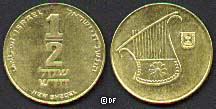
The traditional Masonic Wages are mentioned in the Mark Master's Degree of the York Rite. According to the legend, the wages of a Master Mason working in the construction of the Temple at Jerusalem were half a Sheqel. The legend does not mention the duration of labor time, for which these wages provided a compensation.
While the Temple of Jerusalem was standing, the people of Israel donated half a Sheqel yearly to the Temple. This money paid for communal services, and also, served as a way to count the population, since taking a direct census was forbidden according to Biblical tradition. The tax was paid during the month of Adar, corresponding to parts of February and March, before the beginning of the Biblical fiscal New Year. Even after the Temple was destroyed, the people of Israel still continues the same Biblical tradition of donation for charitable purposes.
Presently, the half New Israeli Sheqel coin in the currency cycle bears on the obverse an ancient Biblical lyre and the emblem of the State of Israel, the menorah (seven-branched candelabrum used in the Biblical Tabernacle and the Temple of Jerusalem). The lyre motif is derived from an ancient Hebrew seal bearing the inscription "Ma'adana (Mah-a'h-dah-nah), the King's daughter."
In Speculative Freemasonry, Masonic Wages are mentioned only symbolically. Benjamin Franklin (1706-1790) described the Masonic Wages as follows:
"Masonic labor is purely a labor of love. He who seeks to draw Masonic wages in gold and silver will be disappointed. The wages of a Mason are earned and paid in their dealings with one another; sympathy that begets sympathy, kindness begets kindness, helpfulness begets helpfulness, and these are the wages of a Mason."

Scottish Rite's Feast of Tishri
The Masonic calendar is based on the ancient Hebrew calendar, which is a lunar calendar, and in which each month goes from new moon to new moon. The Biblical civil New Year starts in Rosh haShanah ('Head of the Year' or 'Beginning of the Year'), in the seventh month, Tishrey (teeshray), which is a celebration month (High Holy Days), corresponding to parts of September and October. The Temple of Jerusalem, built by Solomon, King of Israel, was also dedicated during the month of Tishrey. Some Scottish Rite Bodies around the world observe the Feast of Tishri, as a feast of thanksgiving to perpetuate the Biblical memory. No other occasion epitomizes the character and purpose of Freemasonry more wholly than this historic celebration of the dedication of King Solomon's Temple, the first edifice built for G-d.
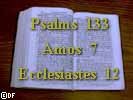
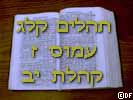
Bible Opening Pages
The Tanach and/or Bible opening pages for the respective degrees of Freemasonry are as follows:
Entered Apprentice: Psalms (Tehillim) 133
A Song of degrees of David. Behold, how good and how pleasant it is for brethren to dwell together in unity. 2Like the precious ointment upon the head, that ran down upon the beard, Aaron's beard, that went down to the skirts of his garments. 3As the dew of Hermon that descended upon the mountains of Zion, for there the L-rd commanded the blessing, life for evermore.
Fellowcraft: Amos 7
Thus hath the L-rd G-d shewed unto me; and behold, he formed grasshoppers in the beginning of the shooting up of the latter growth, and it was the latter growth after the king's mowings. 2And it came to pass, when they had made an end of eating the grass of the land, then I said, O L-rd G-d, forgive, I beseech thee: by whom shall Jacob arise? for he is small. 3The L-rd repented for this: It shall not be, saith the L-rd. 4Thus hath the L-rd G-d shewed unto me: and behold, the L-rd G-d called to contend by fire, and it devoured the great deep, and did eat up the area. 5Then said I, O L-rd G-d, cease, I beseech thee: by whom shall Jacob arise? for he is small. 6The L-rd repented for this: This also shall not be, saith the L-rd G-d. 7Thus he shewed me: and behold, the L-rd stood upon a wall made by a plumbline, with a plumbline in his hand. 8And the L-rd said unto me, Amos, what seest thou? And I said, A plumbline. Then said the L-rd, Behold, I will set a plumbline in the midst of my people Israel: I will not again pass by them any more: 9And the high places of Isaac shall be desolate, and the sanctuaries of Israel shall be laid waste; and I will rise against the house of Jeroboam with the sword. 10Then Amaziah the priest of Beth-El sent to Jeroboam king of Israel, saying, Amos hath conspired against thee in the midst of the house of Israel: the land is not able to bear all his words. 11For thus Amos saith, Jeroboam shall die by the sword, and Israel shall surely be led away captive out of their own land. 12Also Amaziah said unto Amos, O thou seer, go, flee thee away into the land of Judah, and there eat bread, and prophesy there: 13But prophesy not again any more at Beth-El: for it is the king's chapel, and it is the king's court. 14Then answered Amos, and said to Amaziah, I am no prophet, neither am I a prophet's son; but I am an herdman, and a gatherer of sycomore fruit: 15And the L-rd took me as I followed the flock, and the L-rd said unto me, Go, prophesy unto my people Israel. 16Now therefore hear thou the word of the L-rd: Thou sayest, Prophesy not against Israel, and drop not thy word against the house of Isaac. 17Therefore thus saith the L-rd; Thy wife shall be an harlot in the city, and thy sons and thy daughters shall fall by the sword, and thy land shall be divided by line; and thou shalt die in a polluted land: and Israel shall surely go into captivity forth of his land.
Master Mason: Ecclesiastes (Koheleth) 12
Remember now thy Creator in the days of thy youth, while the evil days come not, nor the years draw nigh, when thou shalt say, I have no pleasure in them; 2While the sun, or the light, or the moon, or the stars, be not darkened, nor the clouds return after the rain: 3In the day when the keepers of the house shall tremble, and the strong men shall bow themselves, and the grinders cease because they are few, and those that look out of the windows be darkened, 4And the doors shall be shut in the streets, when the sound of the grinding is low, and he shall rise up at the voice of the bird, and all the daughters of musick shall be brought low; 5Also when they shall be afraid of high, and fears shall be in the way, and the almond tree shall flourish, and the grasshopper shall be a burden, and desire shall fail: because man goeth to his long home, and the mourners go about the streets: 6Or ever the silver cord be loosed, or the golden bowl be broken, or the pitcher be broken at the fountain, or the wheel broken at the cistern. 7Then shall the dust return to the earth as it was: and the spirit shall return unto G-d who gave it. 8Vanity of vanities, saith the preacher; all is vanity. 9And moreover, because the preacher was wise, he still taught the people knowledge; yea, he gave good heed, and sought out, set in order many proverbs. 10The preacher sought to find out acceptable words: and written honesty, words of truth. 11The words of the wise are as goads, and as nails fastened by the masters of assemblies, given from one shepherd. 12And further, by these, my son, be admonished: of making many books there is no end; and much scrutiny is a weariness of the flesh. 13Let us hear the conclusion of the whole matter: Fear G-d, and keep his commandments: for this is the whole duty of man. 14For G-d shall bring every work into judgment, with every secret thing, whether good, or whether evil.
Ahiman Rezon - Hebrew Interpretation
D Farhey
"Ahiman Rezon" is the title of the 'Book of Constitutions' of the Grand Lodges of England (Laurence Dermott 1756), South Carolina (Albert G. Mackey 1852), and others. The term "Ahiman Rezon" is usually explained as "a help to a brother" in different Masonic sources. Part of this description clearly sounds to originate from Hebrew — especially the very beginning (ah' = brother; ah'im = brothers). Let us try a full interpretation using phonetically and logically related Hebrew words:
(Pronunciations given for English speakers.)
In general, due to the basic linguistic differences, transliteration attempts to convert Hebrew words to Latin letters usually lead to alterations of the sounds and misspellings, and therefore to mispronunciations. Also, to write Hebrew words with Latin letters, some Central European Jews use the Latin letter "z" to denote the Hebrew letter "ts," tsadiq (tsahdeeq). This is a historic influence of the Italian and German languages, in which the letter "z" is pronounced "ts."
Now, let us try some combinations in Hebrew:
This is the essence of our craft as a "Fraternity," where good people become "brothers by choice." Furthermore, this also provides a perfect title for a Masonic 'Book of Constitutions.'
Origin of the Fleur-de-Lis Motif
Compiled by D Farhey
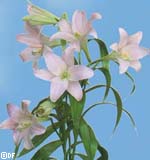
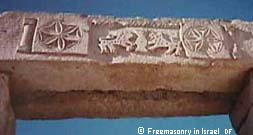
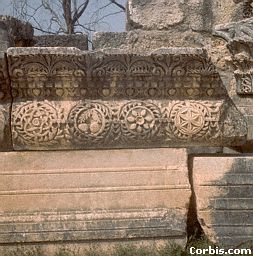
The fleur-de-lis of heraldry is the white lily flower, a perennial bulbous herb of the genus Lilium Candidum of the family Liliaceae. The lily has six petals shaped in the form of a six-pointed star. Consequently, its Hebrew name, shoshan (shohshahn), is derived from the number six, shesh (shehsh). The female given name Susanna and its various forms are transliterations of the Hebrew name Shoshana, derived from shoshan, the lily flower. In heraldic ordinaries and subordinaries, the fleur-de-lis motif represents the sixth son, based on the lily's six petals. This large, beautiful, and delightfully fragrant flower can still be found in the Galilee and Mount Carmel forests in northern Israel.

The Israelites regarded the lily as the choicest among flowers and used it as a source of perfume. In ancient Hebrew poetry, the lily was always a favorite simile as a symbol of purity. Solomon, King of Israel (10th century BCE), allegorically referred to the lily of the valleys, shoshanat haa'maqim (shohshahnaht hah-a'hmahqeem), in his Song of Songs (Canticles 2:1). The conceptualized lily motif graced the capitals of the two main pillars in front of the Temple of Jerusalem. Typical Israelite capitals of columns were adorned with the lily motif during the period 10th-7th century BCE.

The prophet Hosea (8th century BCE) described the lily as the flower symbol of Israel: "I will be as the dew unto Israel; he shall blossom as the lily ..." (Hosea 14:6). From the Second Temple period and later (6th-1st century BCE), the lily became a popular motif in Jewish art and appears as a national symbol together with the inscription YeHuD (Yeh-hood), which means Judea, in various coins minted in Jerusalem, capital of Israel. Both, the fleur-de-lis motif (side view) and the six-petaled star motif (top view) of the lily flower became classical symbols inspiring craftsmen around the world and adorning artistic and architectural designs for over three millennia.
Hebrew Alphabet
Compiled by D Farhey
Hebrew is the national language of the people of Israel. Hebrew developed from the Aramaic, which was a Semitic lingua franca, spoken in southwest Asia circa 1000 BCE. The Hebrew alphabet is considered a sacred national legacy and is used continuously for some 2300 years, since about the 3rd century BCE. To carve letters in stone, it was logical to write from right to left, since most people hold the mallet (or hammer) with the right hand and the chisel with the left.


In Hebrew, verbs have roots consisting of three letters, which are only consonants (and gutturals). Words are derived by appropriate prefixes and suffixes attached to the three-consonant roots. The vowels consist of diacritics (vowel points) attached to the consonants. These change the sound and sometimes even the meaning of a word. Usually though, Hebrew is written without these diacritical vowels, which mutate according to grammatical balance (for example, in pluralization). In most cases, a Hebrew text will thus look shorter than its equivalent in other alphabetical languages.
The sounds of some letters in Hebrew are guttural and do not exist in European languages. Due to all the basic linguistic differences, transliteration attempts to convert to Latin letters usually lead to alterations of the sounds and misspellings, and therefore to mispronunciations. For example, most Biblical names are incorrect in other languages. Also, inaccurately pronounced words resulted in some infamous and blatant translation errors made even by the best researchers, leading to distorted conclusions. Therefore, some translations unaware of the grammatical principles of the Hebrew language are not necessarily 'more authentic,' even if they are older.
Find the letters, diacritics, and transliterations in our page: How to Read Hebrew
Hebrew Alphabetical Numerals
Compiled by D Farhey
In Hebrew and in ancient Greek, numerical values were assigned to the letters for counting purposes. For example:

 +
+  = 14
= 14
 : Daleth (dahleht) = 4
: Daleth (dahleht) = 4 : Yod (yohd) = 10
: Yod (yohd) = 10 : Delta (Greek) = 4
: Delta (Greek) = 4
"Yod" is also the first letter of the original 'Ineffable Name' of G-d in Hebrew, and is sometimes used in religious volumes as an abbreviated equivalent. In nonreligious documents however, observant persons are concerned of using "Yod" to denote the 'Ineffable Name' and use instead the letter "Daleth" as a traditional equivalent.
Find all the numerical values in our page: How to Read Hebrew
International Masonic Peace Prize
Communicated by Leon Zeldis, FPS, 33°
PSGC, Supreme Council of the Scottish Rite for the State of Israel
Honorary Adjunct Grand Master
Editor, The Israeli Freemason
Reprinted from The Israeli Freemason
שלום Shalom (shahlohm): peace; a conventional Hebrew greeting or farewell, equivalent to "hello" or "good-bye"
The Grand Lodge and Supreme Council of Argentina joined together to institute the International Masonic Peace Prize, to be awarded to individuals, both Freemasons and others, as well as institutions, who have distinguished themselves in promoting peaceful coexistence and fraternity among men and nations. The prize was awarded for the first time at an international ceremony held in Buenos Aires on March 28, 1995.
The first recipients of the award were:
Sahir Erman, Past Grand Commander of the Scottish Rite for Turkey; and,
Joseph A.E. Salem, Grand Commander of the Scottish Rite for Israel;
both for their efforts in developing multiracial and religious understanding in their respective countries; and,
Juan Goldwaser, Past Master of La Fraternidad Lodge #62 of Tel-Aviv, Israel,
for his work in strengthening fraternal links between Arab and Jewish Brethren in Israel.
The 1997 Masonic Peace Prize was awarded, among others, to:
R.W. Bro. Elias Mansour, 33°, Honorary Deputy Grand Master, Grand Lodge of Israel; and to
W. Bro. Samir Farran, Past Master of Nazareth Lodge #71, an Arabic-speaking Lodge under the Grand Lodge of Israel.
Both Brethren are Christian Arabs, Israeli citizens, and very active Masons.
Bro. Elias Mansour belongs to a well-known family living for generations in the southern part of Lebanon and northern Israel. He has been tireless in promoting better understanding between the Christian and Jewish communities in general, and closer links between Masons of different religious and ethnic backgrounds.
Bro. Samir Farran, together with Bro. Juan Goldwaser (recipient of the Masonic Peace Price in 1995), established a model of cooperation and intervisitation, developing personal contacts between an Arab Lodge, Nazareth #71, and a mostly Jewish Lodge, La Fraternidad #62.
Oldest Known Building Code of Law
Compiled by D Farhey
From the Code of Laws of Hammurabi, King of Babylonia, 18th Century BCE
Translated by R.F. Harper, "Code of Hammurabi," Univ. of Chicago Press, 1904, p. 83-seq.
| # | Code | Transliteration | Translation |
|---|---|---|---|
| 1 |  |
sum-ma ba-num a-na a-wi-lim bi-tam ibu-us-ma si-bi-ir-su la u-dan-ni-in-ma bitum i-bi-su im-ku-ut-ma be-el bîtum b'us-tami-it ba-nûm su-u id-da-ak. |
If a builder builds a house for a man and does not make its construction firm and the house which he has built collapses and causes the death of the owner of the house, that builder shall be put to death. |
| 2 |  |
sum-ma mar be-el bitim us-ta-mi-it mar banim su-a-ti i-du-uk-ku. |
If it causes the death of the son of the owner of the house, they shall put to death a son of that builder. |
| 3 |  |
sum-ma warad be-el bitim us-ta-mi-it wardam ki-ma wardim a-na be-el bitum i-na-ad-di-in. |
If it causes the death of a slave of the owner of the house, he shall give to the owner of the house a slave of equal value. |
| 4 |  |
sum-ma sa-ga uh-ta-al-li-ik mi-im-ma sa-u-hal-li-ku i-ri-ab u-as-sum bitam i-bu-su la u-dan-ni-nu-ma im-ku-tu i-na sa-ga ra-ma-ni-su a-bitam im-ku-tu i-ib-bi-es. |
If it destroys property, he shall restore whatever it destroyed, and because he did not make the house which he built firm and it collapsed, he shall rebuild the house which collapsed at his own expense. |
| 5 |  |
sum-ma ba-num bitam a-na a-wi-lim i-bu-us ma si-bi-ir-su la-us-te-is-bi-ma igarum ik-su-tu-up ba-num su-u i-na kas pim b'ra-ma-ni-su igarum ik-su-a-ti u-dan-na-an. |
If a builder builds a house for a man and does not make its construction meet the requirements and a wall falls in, that builder shall strengthen the wall at his own expense. |
Copyright © 1997- Freemasonry in Israel. All rights reserved. • Valid XHTML, CSS, WAI, Unicode.
Reproduction, distribution, or publication of any part of this web site, in any form or by any means, constitute infringement of copyright laws.
This web site is NOT the official site, statement, or opinion of any Grand Lodge, Lodge, or individual. All contributions are voluntary and represent only good intention and effort.